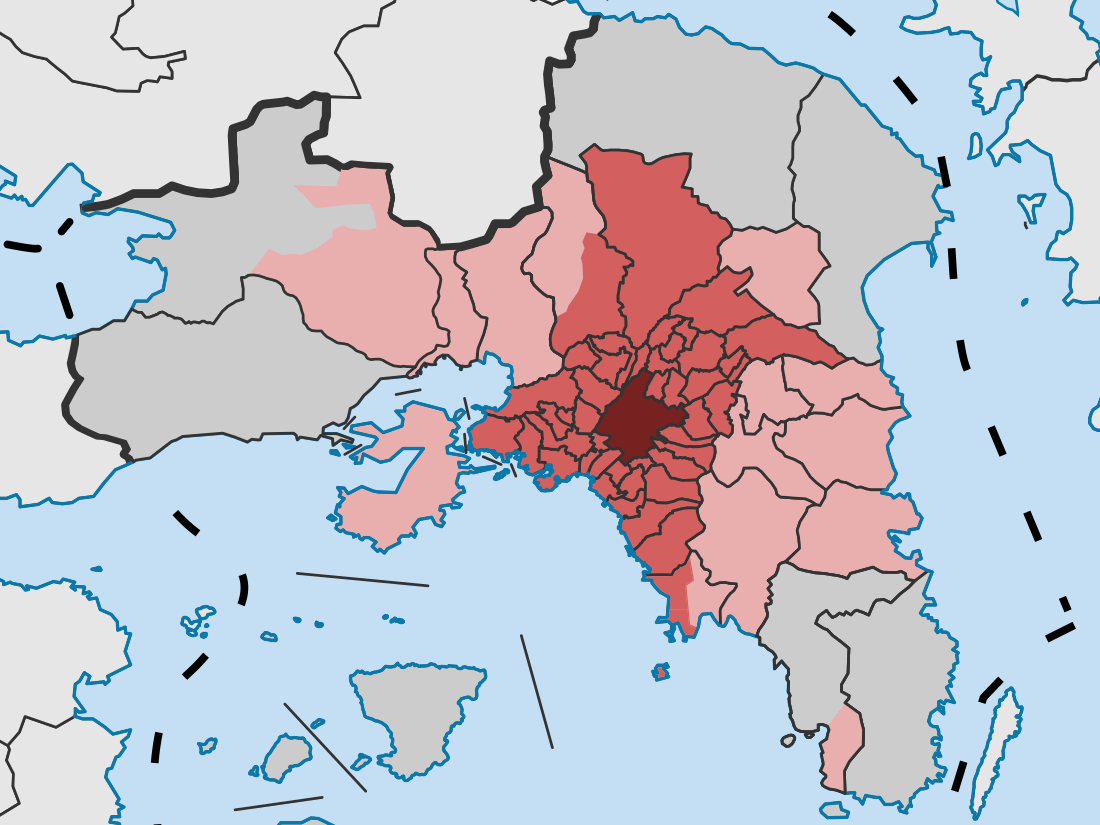Top Qs
Timeline
Chat
Perspective
Athens metropolitan area
Main metropolitan area in Greece From Wikipedia, the free encyclopedia
Remove ads
The Athens metropolitan area (Greek: Μητροπολιτική Περιοχή της Αθήνας) spans 2,928.717 km2 (1,131 sq mi) within the Attica region and consists of 58 municipalities plus parts of East Attica and West Attica, having reached a population of 4,573,179 according to the 2021 census.[2] The municipalities of Athens and Piraeus both serve as the two metropolitan centres of the Athens metropolitan area.[3]
According to the Hellenic Telecommunications and Post Commission, the Athens metropolitan area consists of all areas with a dialing code of 21 and includes areas such as Salamina, Elefsina, Kifissia, Mandra, Magoula, Aspropyrgos, Pallini, Agios Stefanos, Dionysos, Parnitha, Koropi, Vari, Vouliagmeni, Voula and the Athens International Airport.[4][5][6][7]
Remove ads
Administration
The Athens Urban Area, also known as Greater Athens,[8] consists of 40 municipalities, 35 of which make up what was referred to as the former Athens Prefecture municipalities, located within 4 regional units (North Athens, West Athens, Central Athens, South Athens); and a further 5 municipalities, which make up the former Piraeus Prefecture municipalities, located within the regional unit of Piraeus. The Athens Municipality forms the core and centre of Greater Athens, which in turn consists of the Athens Municipality and 40 more municipalities, divided into four regional units, accounting for 2,611,713 people (in 2021) within an area of 361 km2 (139 sq mi). The regional units of Central, North, South, and West Athens, Piraeus and parts of East[9] and West Attica[10] regional units combined make up the continuous Athens Urban Area.[10][11][12]
Remove ads
Climate
Summarize
Perspective
Due to its large area metropolitan Athens has a variety of climates. The largest part of the Athens metropolitan area has a hot-summer Mediterranean climate (Köppen climate classification: Csa), while some areas of the Athens Riviera, some areas of the Thriasio Plain and some areas in the west have a hot semi-arid climate (Köppen climate classification: BSh). According to the meteorological stations of the National Observatory of Athens and the Hellenic National Meteorological Service areas in the north have wetter and colder winters. Dionysos has a January average high of around 9 °C and an average low of 4 °C, while Parnitha mountain has a January average high of around 4 °C and an average low below 0 °C.[13][14][15] Areas in the south have very mild winters with Nea Smyrni recording a January average high of 15 °C and an average low of 9 °C.[13][16]
The highest summer maximum temperatures are recorded in the interior of the Athens Basin and also in west areas with Magoula, Nea Filadelfeia, Harokopio University and Salamina registering July mean maximum temperatures as high as 36.5 °C.[17][18][13][19] Due to land breezes, summer nights can be particularly hot in the south and especially around Piraeus which records an average August low of around 27 °C.[13][20] The highest average annual temperature is recorded in Piraeus Port registering around 20.9 °C, while the lowest is recorded in Parnitha mountain with less than 11.0 °C.[13][21][22] Neos Kosmos is the warmest area of Downtown Athens with an average annual temperature of 20.2 °C and a hot semi-arid climate (Köppen climate classification: BSh) closely bordering a hot-summer mediterranean (Csa) climate. During July 2024 minimum temperatures remained over 30 °C (86 °F) for 12 consecutive days in metropolitan Athens, breaking all known records for any area in the country.[23][24]
The lowest average annual precipitation in metropolitan Athens is recorded in Piraeus Kallipoli with 304 mm, while the highest average annual precipitation is recorded in Parnitha mountain with around 720 mm.[13][25][26] The highest temperature ever recorded in the Athens metropolitan area was 48.0 °C in Elefsina and Tatoi on July 10, 1977 which according to the World Meteorological Organization was also the highest official temperature ever recorded in Europe until 2021.[27] The lowest temperature ever recorded was −12.0 °C in Parnitha mountain on January 9, 2017.[28] The highest minimum temperature of 32.9 °C (91 °F) was recorded on July 26, 2023 in Hellinikon.[29] Furthermore, Metropolitan Athens has experienced temperatures of 47.5 °C and over in four different locations.
Regarding the whole of the Attica peninsula, the lowest average annual precipitation is found in Anavysos, Athens Riviera with around 290 mm, while the highest average annual precipitation is found in Avlonas with around 910 mm.[30] Lavrio is the only area in mainland Attica that has never recorded an air frost according to the National Observatory of Athens station which operates since 2008.[31][13]
Remove ads
References
Wikiwand - on
Seamless Wikipedia browsing. On steroids.
Remove ads


